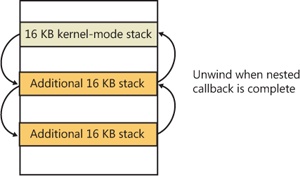Whenever a thread runs, it must have access to a temporary storage location in which to store function parameters, local variables, and the return address after a function call. This part of memory is called a stack. On Windows, the memory manager provides two stacks for each thread, the user stack and the kernel stack, as well as per-processor stacks called DPC stacks. We have already described how the stack can be used to generate stack traces and how exceptions and interrupts store structures on the stack, and we have also talked about how system calls, traps, and interrupts cause the thread to switch from a user stack to its kernel stack. Now, we’ll look at some extra services the memory manager provides to efficiently use stack space.
When a thread is created, the memory manager automatically reserves a predetermined amount of virtual memory, which by default is 1 MB. This amount can be configured in the call to the CreateThread or CreateRemoteThread function or when compiling the application, by using the /STACK:reserve switch in the Microsoft C/C++ compiler, which will store the information in the image header. Although 1 MB is reserved, only the first page of the stack will be committed (unless the PE header of the image specifies otherwise), along with a guard page. When a thread’s stack grows large enough to touch the guard page, an exception will occur, causing an attempt to allocate another guard. Through this mechanism, a user stack doesn’t immediately consume all 1 MB of committed memory but instead grows with demand. (However, it will never shrink back.)
Although user stack sizes are typically 1 MB, the amount of memory dedicated to the kernel stack is significantly smaller: 12 KB on x86 and 16 KB on x64, followed by another guard PTE (for a total of 16 or 20 KB of virtual address space). Code running in the kernel is expected to have less recursion than user code, as well as contain more efficient variable use and keep stack buffer sizes low. Because kernel stacks live in system address space (which is shared by all processes), their memory usage has a bigger impact of the system.
Although kernel code is usually not recursive, interactions between graphics system calls handled by Win32k.sys and its subsequent callbacks into user mode can cause recursive re-entries in the kernel on the same kernel stack. As such, Windows provides a mechanism for dynamically expanding and shrinking the kernel stack from its initial size of 16 KB. As each additional graphics call is performed from the same thread, another 16-KB kernel stack is allocated (anywhere in system address space; the memory manager provides the ability to jump stacks when nearing the guard page). Whenever each call returns to the caller (unwinding), the memory manager frees the additional kernel stack that had been allocated, as shown in Figure 10-31.
This mechanism allows reliable support for recursive system calls, as well as efficient use of system address space, and is also provided for use by driver developers when performing recursive callouts through the KeExpandKernelStackAndCallout API, as necessary.
Finally, Windows keeps a per-processor DPC stack available for use by the system whenever DPCs are executing, an approach that isolates the DPC code from the current thread’s kernel stack (which is unrelated to the DPC’s actual operation because DPCs run in arbitrary thread context). The DPC stack is also configured as the initial stack for handling the SYSENTER or SYSCALL instruction during a system call. The CPU is responsible for switching the stack when SYSENTER or SYSCALL is executed, based on one of the model-specific registers (MSRs), but Windows does not want to reprogram the MSR for every context switch, because that is an expensive operation. Windows therefore configures the per-processor DPC stack pointer in the MSR.
